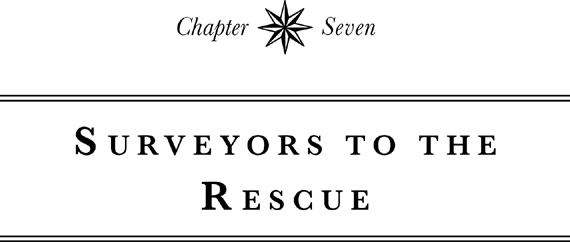

BY SEPTEMBER 3, 1763, Lord Baltimore’s agent (and uncle), Cecilius Calvert, had informed Maryland’s governor Horatio Sharpe of the surveyors’ imminent departure from London.
Mason and Dixon boarded the Hanover Packet and left for Pennsylvania in mid-September. After sixty-four days at sea, the two men welcomed the sight of salt-marsh grasses rippling along the fringe of Delaware Bay. Eager to be on land, they disembarked as soon as the ship dropped anchor at Marky’s Hook, the first port of call for Philadelphia during colonial times, located about twenty miles south of the city. Eager to complete their journey, Mason and Dixon hired two horses — this would be the first of many horseback rides on American soil — and arrived in Philadelphia on November 15. They saw the steeples of Christ Church and the State House towering above the city’s center. It was at the State House where they would formally meet with boundary-line commissioners from both provinces.
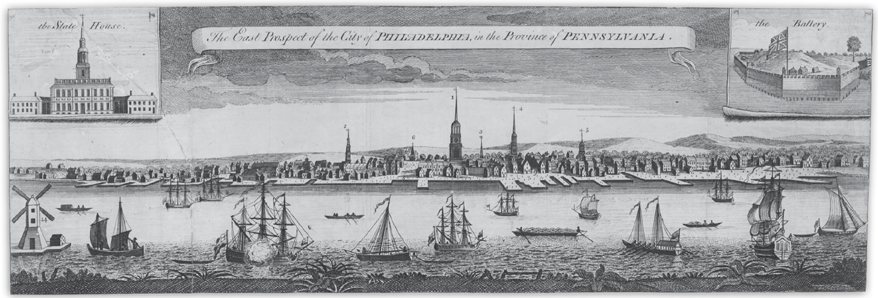
Philadelphia bustled with activity in the early 1760s. The tallest steeple belongs to Christ Church. The farthest steeple to the left is that of the State House (also shown in the left-hand inset and now called Independence Hall), where Mason and Dixon met with the commissioners.
In 1763, Philadelphia was home to about twenty thousand people — six times the number that had lived there when William Penn sailed away from the city for the final time in 1701. Wood and brick buildings lined the streets. The air was filled with a constant clamor of shopkeepers hawking their wares and harnesses jingling as carriage wheels rumbled over uneven cobblestone streets. Although these same sounds could be heard in England, the effect on the surveyors was brand-new. Philadelphia was a city of strangers. And just beyond the city’s western limits were unfamiliar plants and animals. Perhaps the pair would meet native people. For the two men, America was more than a place to complete a job. It was the start of an adventure.

Within twenty-four hours of their arrival in Philadelphia, Mason and Dixon met with Pennsylvania’s boundary commissioners. They presented a letter from Thomas Penn requesting that the boundary commissioners provide instructions to the surveyors, as specified in the agreement among the surveyors, the Penns, and Lord Baltimore. An express rider galloped to Annapolis, Maryland, with a note informing Governor Sharpe of Mason and Dixon’s arrival.
A flurry of activity filled the next week as Mason arranged and paid for the “landing and carriage” of their instruments to their lodgings, where he and Dixon set up and examined the zenith sector and the transit and equal altitude instrument. Inspection and testing of these crucial astronomical instruments revealed that both were in good working order.
Meanwhile, Maryland’s boundary-line commissioners prepared for travel. Their arrival in Philadelphia on the last day of November heralded a week of meetings that began promptly at ten o’clock each morning. The meetings outlined Mason and Dixon’s tasks, including the survey and marking of two boundary lines. One was the West Line, a 233-mile-long boundary that ran along the parallel of latitude stipulated by England’s Court of Chancery as being located fifteen miles south of the southernmost point of the city of Philadelphia. (City officials had already determined that this point was the north wall of the Plumstead-Huddle house on Cedar Street, which straddled the city line.) The other line was the Tangent Line, the eastern boundary that separated Maryland from the Three Lower Counties. This line, which had defeated earlier surveyors, was Mason and Dixon’s ultimate challenge. But describing Mason and Dixon’s job as running two boundary lines isn’t quite accurate, because surveying those lines was impossible without first completing several preliminary tasks and additional surveys. Mason and Dixon also had to prepare for the physical challenges of the terrain, as well as the looming threat of violence along the western frontier.
In the meetings, the commissioners discussed logistics such as food, tents, helpers, and wagons. They agreed they would periodically disburse money, supplied by the lords proprietors of both provinces, to Mason and Dixon for the payment of laborers and the purchase of supplies. Then the commissioners bickered about which boundary line should be surveyed first. Maryland commissioners insisted that the West Line — the longest line — be given top priority. They said the surveyors should survey westward until July 15 or until they reached a place called South Mountain (about ninety miles west of Philadelphia), whichever came first. They noted that Mason and Dixon could also stop if they ran into “Danger from the Incursions of the Indians.” The Pennsylvania commissioners insisted that the Tangent Line be run first. They worried that “if the Business of running the Tangent Line should not be entered upon by the month of June, there would be Danger of its being unfinished till another Year, as it can be run only during the Summer Season, the land being naturally low and wet.” Since Mason and Dixon’s wages were paid according to the number of days they were present for the job, delays due to seasonal conditions would increase the cost of the project.
The commissioners decided that Mason and Dixon should begin with one of the preliminary tasks: determining the latitude of the southernmost point of Philadelphia. From that latitude, the surveyors could determine the line of latitude that lay fifteen miles to the south, which would be the West Line. Running the West Line without first completing this task was impossible.
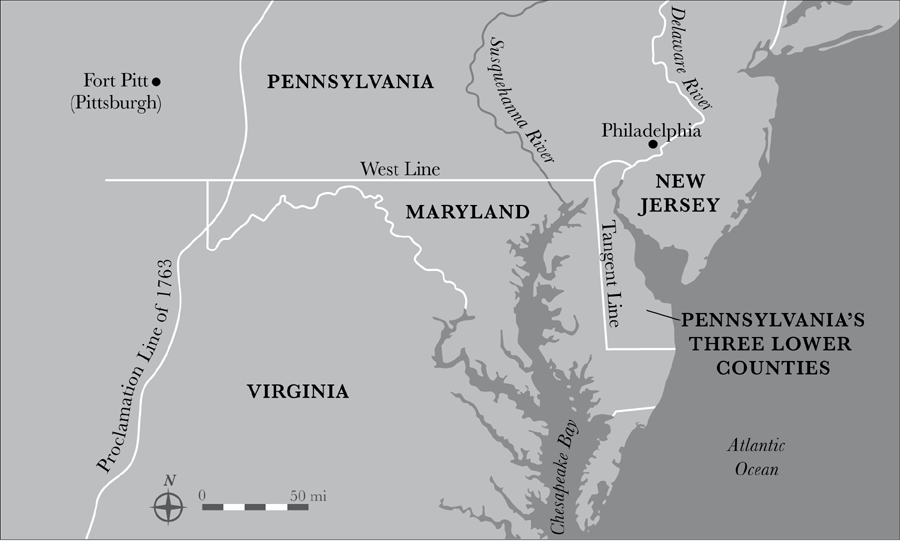
During their meeting, the commissioners and surveyors determined the order in which the boundary lines were to be surveyed. The Proclamation of 1763 forbade colonists from homesteading to the west, which was declared Indian Territory by King George III.

The lords proprietors required Mason and Dixon to keep records of the monies they paid and received while running the boundary lines. This detail from a larger image of Mason’s accounts lists the cash he paid out, in pounds, shillings, and pence, in the three columns on the right.
Mason and Dixon asked that their instruments be “made accessible to use in an observatory as soon as possible.” Before doing so, the commissioners required Mason and Dixon to swear an oath that they would “use their best skills and knowledge and show no partiality to either Penns or Calvert.” Finally, the commissioners gave Mason and Dixon a detailed set of instructions based on the decisions made during the previous week. Along with the instructions, they gave the surveyors two blank journals, with the order to document their progress:
You are to enter fair minutes of your proceedings in two books to be by you kept for that purpose which minutes are every day to be signed by both of you and in such minutes you will take notice of the most remarkable buildings waters bridges and roads that may be near the lines which you are to run on through which the lines may pass.
Work began several days later. A carpenter hired by the commissioners built a wooden observatory on Cedar Street, near the Plumstead-Huddle house, similar to the one Mason and Dixon had used for observing the transit of Venus. Winter weather reared its head just when the surveyors were ready to begin work. Rain and snow slickened streets as winds from a “violent storm” whipped the city on December 14 and 15. Fearing that gusts would blow away the top of the observatory, Mason and Dixon wasted no time in hiring men to tie it down with cords. Even as the surveyors struggled with violent weather, news of another sort of violence reached Philadelphia.

Along Pennsylvania’s western frontier, tensions between European colonists and native inhabitants had stretched to the breaking point. Territorial boundaries were definitely at stake, but cultural differences between European and native peoples also acted as a boundary that further enflamed the situation. Just months before Mason and Dixon arrived in Philadelphia, an Ottawa leader named Pontiac allied several tribes and led them in attacks against British forts and settlements in western Pennsylvania.


IN ABOUT AD 1500, five Indian nations — the Mohawk, Onondaga, Oneida, Seneca, and Cayuga — formed bonds of peace and established a league that became known as the Five Nations. Occupying areas of upstate and western New York, they called the league the Haudenosaunee, or People of the Longhouse. French explorers called them the Iroquois. Sometime around 1720, the Tuscarora Indians moved north from their homeland in North Carolina and joined the Iroquois League. Afterward, the league became known as the Six Nations. During the French and Indian War, the Iroquois allied with the British. At Grand Council assemblies, fifty sachems gathered for formal discussion and consideration of issues that concerned the welfare of the tribes. William Johnson, the king’s agent for Indian affairs, regularly met with members of the Six Nations and attended Grand Council meetings when political issues arose between the colonies and the league members.
The Six Nations were not the only native peoples who lived in the area. Many others lived west of England’s colonial boundaries. By the time Mason and Dixon’s boundary-line survey began, decades of colonial expansion had pushed the Lenni-Lenape, whose traditional homeland lay between the Delaware and the southern Hudson Rivers, into a swatch of land across northern and western Pennsylvania and the Ohio Territory. Similarly, the Shawnee, who had lived along the Susquehanna River in eastern Pennsylvania, had been pushed back to the far western reaches of Maryland and Pennsylvania and into Ohio. Both groups had been allies of the French, and both were long-standing enemies of the Six Nations.

Other native groups had allied with English settlers. A community of about twenty Conestoga Indians lived near the town of Lancaster, on land granted to them by William Penn more than sixty years earlier. They supported themselves by growing corn and selling baskets, brooms, and other handmade goods. A colonist named Rhoda Barber later described the Conestogas as “entirely peaceable and seem’d as much afraid of the other Indians as the whites were.” Almost every day, the Barber boys played with Christie, a young Conestoga boy. Christie made them bows and arrows; the brothers gave him a toy gun. The Conestogas and the settlers were neighbors and friends.
On December 13, the Paxton Boys, a gang of about fifty frontier militiamen, rode into the area. Their anger over recent Indian raids on the western and northern frontiers had long passed the boiling point. They considered all Indians their enemies, believing that even friendly Indians were secret spies. That night, revenge and retaliation filled their minds. They targeted Will Sock, a Conestoga man they suspected of conspiring with hostile Indians.
Heavy sleet and snow kept the Barber family inside their home the morning of December 14. Sudden loud knocking at their door surprised them. Opening the door, Mr. Barber found five or six men slapping snow from their coats. They said they were cold and asked to warm themselves at the Barbers’ hearth. Upholding the frontier code of hospitality to travelers, Mr. Barber invited them in and offered them hot refreshments. While the men talked, the Barber boys snuck outside to look at the men’s horses. Blood-covered tomahawks dangled from the saddles. Even more frightening, Christie’s toy gun hung among them. As soon as the men left, the boys told their father what they’d seen. Even as Mr. Barber was deciding what to do, a neighbor arrived with shocking news: men had attacked the Conestogas and set their homes afire.
Mr. Barber and his friends hurried to the Conestogas’ land. Among the still-smoldering ruins, they found the bodies of six of their Indian neighbors — three men, two women, and a boy. All had been horribly murdered. Christie was missing.

News of the massacre quickly spread to Philadelphia. Charles Mason later recorded information about the massacre in his journal, so there is little doubt that the surveyors discussed the disturbing events while the story was breaking news. Despite unsettled minds, their commissioned job required them to turn their attention to the work of determining the latitude of the southernmost point of Philadelphia.
Mason and Dixon’s first order of business was setting up their telescope in their newly constructed observatory. They would be using a vertically mounted telescope called a zenith sector, made by English astronomer John Bird. Mason would be using it to measure an angle called the zenith distance. A zenith distance is the angle created between a star’s position on the celestial sphere, an observer standing on Earth, and the zenith, the point on the celestial sphere directly above the observer. Once Mason knew a star’s zenith distance, as measured with the sector, and the star’s declination (the celestial equivalent of latitude), which he could find in the Royal Society’s star table, he could mathematically calculate the latitude of the spot where the zenith sector was located.
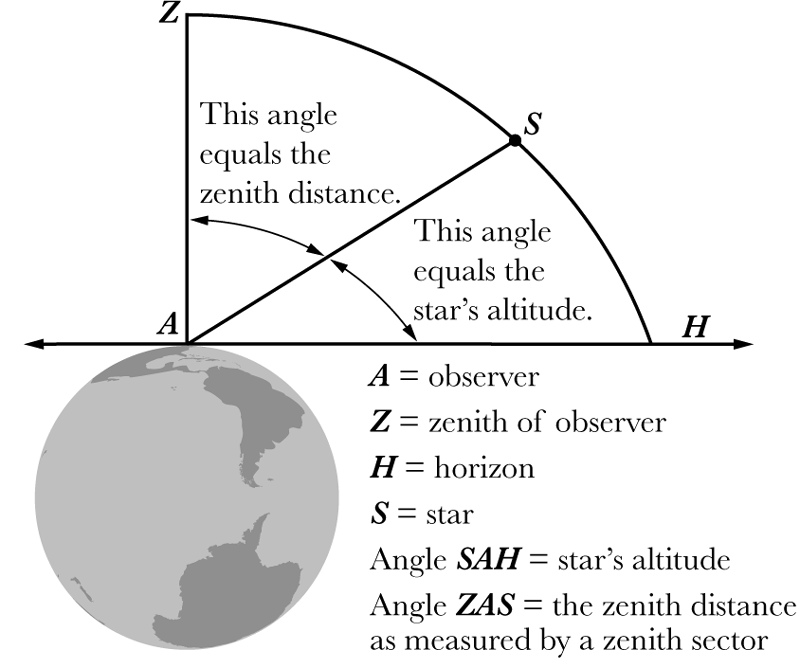
In order to compute his latitude, Charles Mason first used a special telescope called a zenith sector to measure the angle between his zenith and a chosen star.
Using the zenith sector was a multistep process. First, Mason fastened the sector’s stand to a stable base and adjusted it until it was absolutely level. Next, he mounted the telescope vertically in the stand. The telescope, which pointed straight up, could pivot, so Mason could adjust its position during his observations. A slightly curved scale called a sector was attached to the instrument’s base. The sector was a small segment of an arc taken from a circle that had a six-foot radius. The sector was inscribed with increments of degrees. A plumb bob was suspended from the sector so that Mason could make sure the instrument was perfectly vertical.
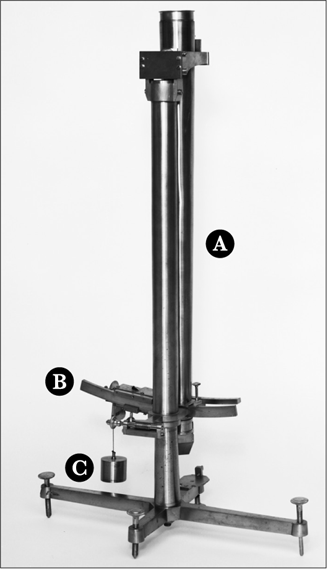
This is a zenith sector, similar to the one Mason used. (A) is the telescope; (B) is the sector, used for measuring the zenith distance; and (C) is the plumb bob, used to ensure that the instrument was vertical.
Because the eyepiece of the telescope was near the ground, Mason had to lie flat on his back to use it. When peering through the eyepiece, he saw two very fine wires — one horizontal and one vertical — that crossed each other, perpendicularly, exactly in the center of the telescope’s view. Since Mason used the telescope at night, Dixon (or another helper) would illuminate the wires by holding a candle alongside a hole in the side of the eyepiece.
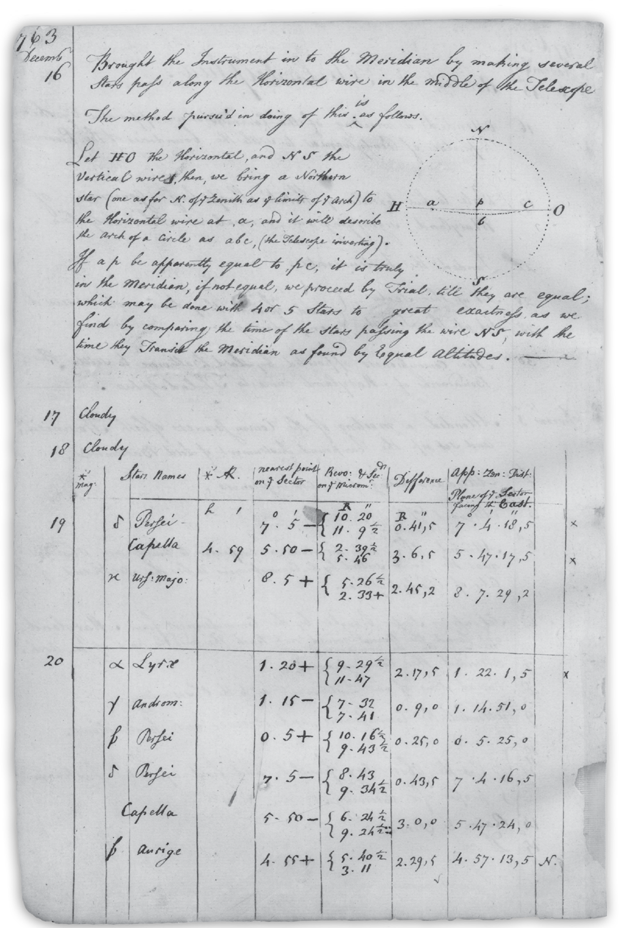
A page from Mason’s daily journal. The circular diagram at the top shows the crossed wires he saw when peering through the telescope of the zenith sector. Arc abc, which dips below the horizontal wire, shows the path of a star as time passes. The names and positions of the stars Mason observed are recorded on the bottom half of the page. Mason used the stars’ Greek and Latin names.


IN RELATION TO THE SUN, Earth completes one revolution on its axis (360 degrees) every twenty-four hours. Astronomers call this one solar day. Our clocks are designed to operate relative to the solar day. But relative to a star’s fixed position, Earth completes its 360-degree revolution in twenty-three hours and fifty-six minutes, slightly faster than a solar day. Astronomers call the rotation with respect to the stars a sidereal day. Earth is divided into twenty-four sidereal hours, the same as right ascension. In fact, the local sidereal time is always equal to the right ascension of any star that lies on the observer’s meridian. (Sidereal time and the time on a clock do not always match. For that reason, Mason and Dixon recorded both sidereal time and the time measured by a pendulum clock.)
A star’s position in the celestial sphere is fixed. Right ascension and declination, like longitude and latitude on Earth’s surface, pinpoint the star’s location. But a sidereal day’s shorter length affects the clock time of when we first see a star at night. As measured by a clock, a star rises almost four minutes earlier each night. For example, on June 1, a particular star first appears above the horizon at 10:00 p.m. On June 2, it rises at 9:56 p.m., when one full rotation of Earth, relative to that star, has been completed. On June 3, the star rises at 9:52 p.m. After a month, the star’s first appearance above the horizon is nearly two hours earlier (120 minutes divided by 60 minutes equals 2 hours) than when it first rose on June 1.
If we kept clocks relative to sidereal time, noon would gradually shift four minutes a day until lunchtime would be in the middle of the night. The four-minute discrepancy between solar time and star time makes a big difference when it is part of an equation being used to plot one’s location on Earth. For that reason, Mason and Dixon meticulously tested the accuracy of their pendulum clock or a pocket watch by noting whether the clocks were gaining or losing time when compared with sidereal time.


Mason pointed the sector’s telescope at the sky through an opening in the observatory’s roof. His first task was to align the zenith sector in the meridian, the north-south celestial line directly above him. The accuracy of all of his observations depended on getting this alignment exactly right. To align the sector, he watched four or five stars, one after another, pass across the wires in his view. Because of Earth’s rotation, during the course of a night, each star would appear to travel across the sky in an arc-shaped path parallel to the celestial equator. As the star moved across the telescope’s view, the arc of its path carried it across the horizontal wire twice — once on each side of the vertical wire. Dixon recorded the exact times when each star crossed the two wires. When a star crossed the vertical wire, the highest point of the arc, the star was on the meridian. Using the positions of the stars and the times when they were on the meridian, Mason could adjust the position of the zenith sector so that it, too, was in the meridian.
Mason double-checked the sector’s results by dividing by two the time that lapsed between the first and second times a star crossed the horizontal wire. On subsequent nights, if the sector was correct, the clock or watch would confirm that a star crossed the vertical wire halfway between the two points in time. Mason repeated this comparison many times during the course of the boundary-line survey.
With the zenith sector accurately aligned with the meridian and pointing vertically at the opening in the roof, Mason and Dixon began collecting the information necessary to determine the latitude of Philadelphia’s southernmost point. They had chosen ten specific stars to observe and track. Weather permitting, even on Christmas night, they looked at and recorded information about five or six of those ten. Mason slightly tilted the telescope until he centered a star in the cross wires. Then he measured the star’s zenith distance with the micrometer, a very precise measuring device attached to the telescope. No other scientific instrument of the period surpassed the accuracy of John Bird’s zenith sector. It could accurately measure the angle of the zenith distance to within a fraction of seconds of a degree of arc. From December 19, 1763, to January 4, 1764, the two surveyors made many observations. They recorded the zenith distances of select stars. They noted right ascensions. They wrote down the sidereal times of the selected stars and compared them with times noted on the observatory’s clock. They consulted the star tables for declination. Mason and Dixon were delighted with the sector’s precision and were confident they would soon know the latitude of the southernmost point of Philadelphia.
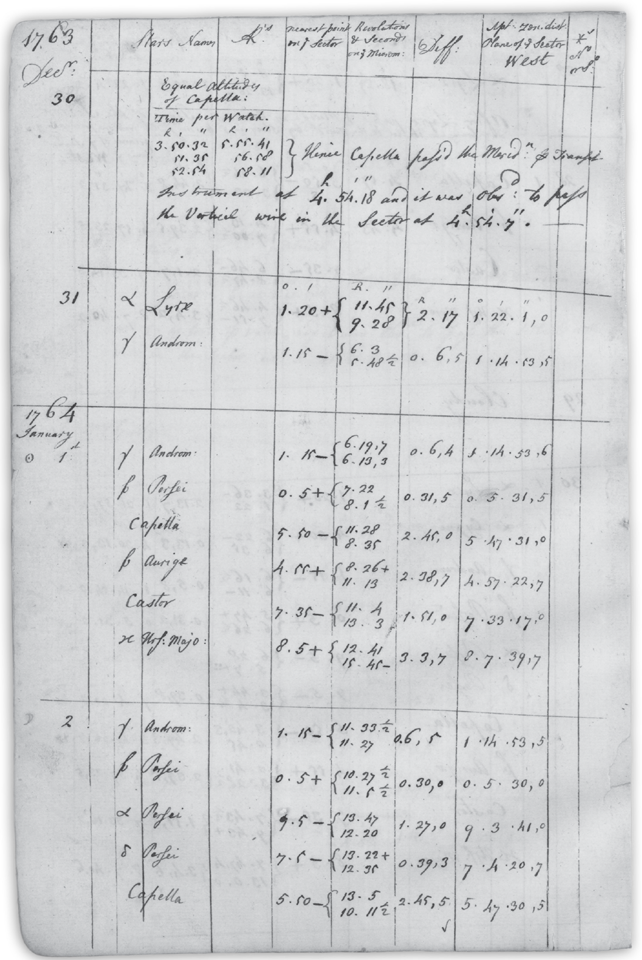
This page from Mason’s journal records the stars he observed from December 30, 1763, through January 2, 1764, and their positions in the sky.

Unfortunately, the good news of the sector’s success was tempered by upsetting news as more information concerning the Conestoga Indians filtered into Philadelphia. Young Christie, awakened by gunshots and screams, had escaped from his house. He had run to the home of Captain Thomas McKee and told him what had happened — including the fact that thirteen Conestogas had been away from home at the time. Christie didn’t know what had happened to those still at home.
According to rumors, the Paxton Boys still intended to kill Will Sock, who was not among the dead. Fearing for the remaining Conestogas’ safety, local magistrate Edward Shippen placed them into protective custody. By December 17, fourteen Conestogas — four men, three women, three little girls, and four young boys, including Christie — sheltered inside Lancaster’s new brick workhouse, guarded by the sheriff. Express riders galloped messages between township and provincial authorities. Officials requested that anyone with information about the perpetrators of the crime step forward. John Penn, the governor of Pennsylvania and a grandson of William Penn, issued a proclamation for the capture of the men who had “inhumanly killed six of the Indians.”
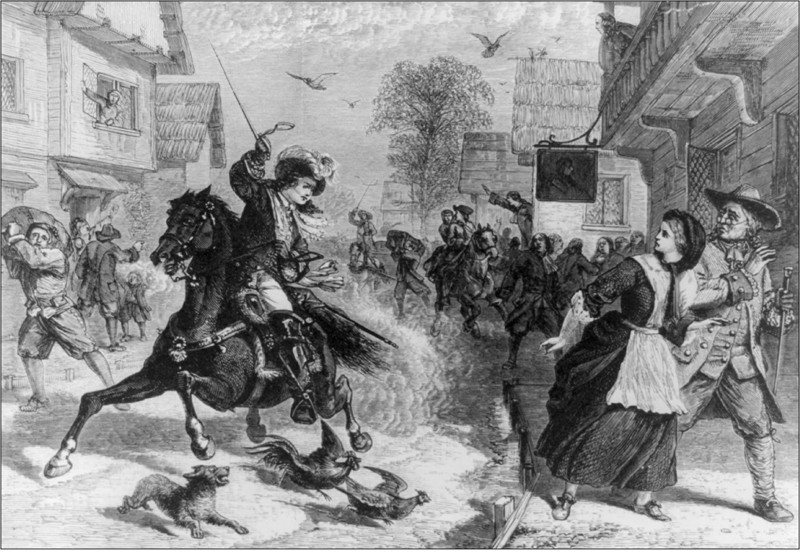
After the Paxton Boys’ December 27 massacre of the Conestogas in Lancaster, their mob grew. Nearly 250 men, angered by Indian attacks on the colonial frontier, reached the outskirts of Philadelphia. Benjamin Franklin and other community leaders persuaded them not to storm the city.
Meanwhile, the Paxton Boys readied themselves for another attack. At midafternoon on December 27, between eighty and one hundred men carrying “Muskets, Tomahawks, & Scalping knives” rode into Lancaster. They dismounted and walked to the workhouse. Threatened by the armed mob, Sheriff John Hay and the coroner, Matthias Slough, stepped aside. The Paxton Boys broke in the workhouse door and, in a manner even more brutal than the first attack, massacred the unarmed Conestogas inside. No one escaped. After less than twelve minutes, the Paxton Boys left the workhouse, mounted their horses, and rode out of town. None of them was ever caught.
The news of the Lancaster murders further horrified Mason and Dixon. But they still needed to continue their work. By the end of the first week of January 1764, the surveyors had finally finished stargazing. Mason completed his calculations. (Without calculators or computers, several days of mathematical computation always followed long periods of observing the stars.) After two days, he informed the commissioners that the latitude of the southernmost point of Philadelphia was 39 degrees 56 minutes 29.1 seconds north (39°56′29.1″ N).

With one preliminary task accomplished, the surveyors moved on to the second: surveying to a point fifteen miles south of their current location — which would be the latitude for the West Line, the long boundary line that ran east to west between the provinces. However, traveling directly south fifteen miles and then turning west would have required surveying across the wide Delaware River twice. Mason and Dixon avoided the unnecessary inconvenience by first riding thirty miles west of the southernmost point of Philadelphia to a location where they could survey southward far from the course of the Delaware River.
Richard Peters, one of Pennsylvania’s boundary commissioners, had assisted the survey crew in running a temporary boundary line in 1739. Peters knew that wilderness travel was arduous. Before Mason and Dixon left town, he sent them a friendly letter that began, “Gentleman: I hope you have pleased yourselves with good horses and an agreeable companion.” Their companion may have been Joel Baily, a clockmaker and gunsmith, who lived three miles from the surveyors’ destination. An experienced surveyor, Baily was also interested in astronomy. He accompanied them to John Harlan’s home, at the fork of Brandywine Creek. Harlan, a Quaker, agreed to board the surveyors and also told them they could erect their wooden observatory in his garden. In the years that followed, Harlan’s sturdy stone house would become Mason and Dixon’s American home. They would come to know Harlan’s wife, Sarah, and their five children as if they were family.
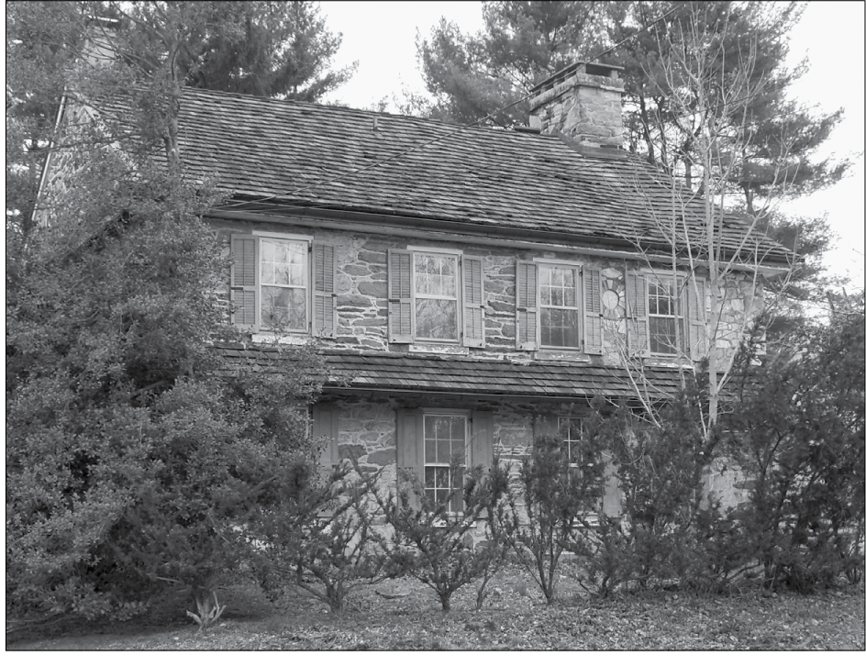
John Harlan’s stone house, at the fork of Brandywine Creek, became Mason and Dixon’s home away from home while they were in America.
For now, Mason and Dixon returned to Philadelphia and prepared to move west. Two carpenters dismantled the observatory and “put [it] with the rest of our Instruments into the wagons.” The surveyors feared that a bone-rattling two-day wagon ride would damage the zenith sector, so rather than loading it with the other instruments, it was wrapped, boxed, and then “carried on the Springs (with Feather bed under it) of a single Horse chair [carriage].” Both carpenters accompanied the surveyors back to Harlan’s house.
Eager to begin, Mason and Dixon set up the zenith sector inside a tent in the garden. They used the stars Capella and Beta Aurigae to confirm their location. The zenith sector’s measurements pleased Mason: “Finding we were very near the Parallel [of latitude] of the southernmost point of Philadelphia, we ordered Carpenters to Erect the Observatory.”
The surveyors sent regular dispatches to the boundary commissioners to report their progress. At the end of January, Mason wrote to Commissioner Peters,
I’ve here the pleasure to acquaint you that all our Instruments came here without receiving the least damage. By the few observations we have made, our situation is not far from the Parallel requir’d. As soon as we have settled the south end of the 15 miles, we shall not fail to acquaint you of it. A great number of Labourers will then be wanted.
Occasionally, Mason interjected a personal request. Thinking of letters from his family that might arrive in Philadelphia during his absence, he noted to Peters:
When I left Philadelphia I desired the Post Master to deliver my Letters (if any should come from England) to you, a freedom I humbly beg you will pardon, and be pleas’d to keep them ’till opportunity serve to send them to hand and the favour will always be acknowledg’d.
During January and February, Mason and Dixon came to know John Harlan’s yard well. But working in the garden was no picnic. They slogged through slush after mid-January snows. They shivered until the observatory’s broken stove was mended. And even afterward, being in the observatory was still colder than sitting by the large fireplace in the Harlans’ home. At the end of a long night’s work, they were glad to climb the steep stairs up to their beds in the warm house.
By the end of February, Mason and Dixon had determined that the latitude of the observatory in Harlan’s garden was 39°56′18.9″ north. This was 10.5 seconds of latitude farther south than the southernmost point of Philadelphia. Mason noted the difference in his journal. He would account for this difference mathematically later, when he and Dixon were fifteen miles farther south and determining the actual latitude of the West Line. Finally, with the latitude of Harlan’s garden established, they began their second preliminary task: measuring to the parallel of latitude that was fifteen miles south.
Nearly two weeks of gray skies, snow, and rain delayed them, leaving everyone as gloomy and cold as the weather. One evening, during a short break in the “flying clouds,” Mason observed the polestar, also known as the North Star or Polaris, just as it crossed the meridian directly above him. Mason realized that physically marking the meridian’s location on the ground would be a daytime anchor for Dixon’s instrument and make his surveying work easier. To mark the meridian’s location, the surveyors turned a large, oblong rock on end and settled it in the soil — a digging job that was likely assigned to the considerably younger backs of the Harlans’ oldest sons, Phinehas and Jesse.
But cloudy skies during his observation of the polestar left Mason questioning the accuracy of the rock’s placement. A week later, under clear skies, Mason observed the polestar again and had his crew reposition the rock to mark the meridian more accurately. Dixon often used the rock as a benchmark when surveying and measuring distances from the observatory. It wasn’t long before the Harlans and their neighbors started calling the large rock the Stargazer’s Stone.
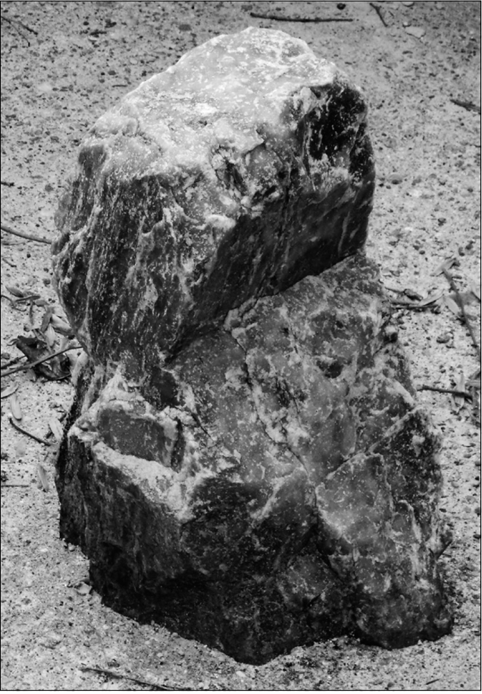
The Stargazer’s Stone, placed in the Harlans’ yard, anchored Mason and Dixon to the meridian.
On Sunday, March 17, the night sky offered a special treat: a lunar eclipse. Though Mason had seen many eclipses, the spectacular event impressed him: “The edge of the Sun’s Shadow on the Moons disk was the best defined I ever saw.” Afterward, clear skies and clear weather allowed the survey party to begin its fifteen-mile trek south.